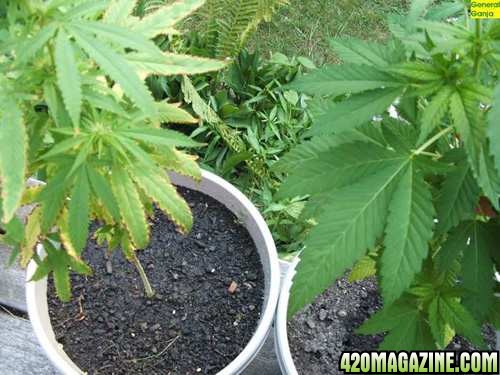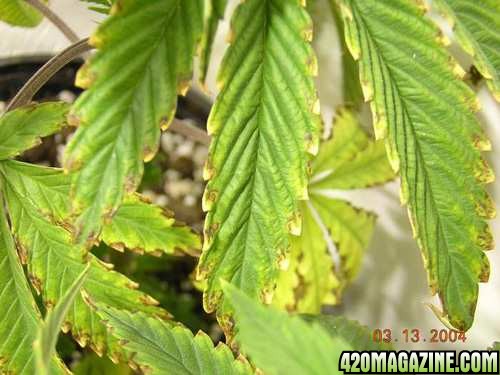freed
Well-Known Member
I’ll be interested in what you find.
Thanks
Thanks
How To Use Progressive Web App aka PWA On 420 Magazine Forum
Note: This feature may not be available in some browsers.

Ha! Nice of you to say. I like growing plants and doing experiments and try to pass along anything I learn that I think others might be interested in.Your work awes me, Azi!
I know, no pics.....
Just out of curiousity, how many hours a week do you spend on doing all this?
Cheers!
are you putting greensand in your soil mix?My K issue at about week 2-3 of flower continues even with the added banana JLF I've been using. Doesn't seem as aggressive a deficiency as last couple of rounds but it's still early.
So I'm going to try a bit of a different approach going forward. I'm going to start adding alfalfa as a top dressing as well as adding it as an amendment in my compost and worm castings. I can get a 40lb bag of pellets at a farm supply store for about the same cost as a 10lb bag sold as a garden amendment so that should give me a healthy supply to experiment with in various ways.
I'll probably also add it as an amendment in my soil mix as this seems to be a consistent issue I'm having since I began making my own soil mix.
Other than that the plants seem pretty good so if I can resolve this issue I may have that repeatable mix and process I've been working toward.
I also started a 5 gallon bucket of seaweed JLF that I use as a component in my veg nutes. It's a pretty small component so 5 Gallons is a multi-year supply. My comfrey and stinging nettle have popped up so I'll get buckets of each of them going in the next month or two once I have enough plant mass to harvest.
No. I do have seaweed JLF as a key component in my veg feed so it should be somewhat represented. I'll check on the kelp meal and Greenland.are you putting greensand in your soil mix?
I think it's definitely a K deficiency. Bright yellow serrations. But could that be caused by a Ca deficit or something else?A K deficiency looks like nute burn and a Mg def combined. Burnt serrations and yellowing between the veins. No yellowing means nute burn.
You say veg feed, do you use it in flower too? If you stopped your K input and a K def arises... jus sayin... try adding it back in?No. I do have seaweed JLF as a key component in my veg feed so it should be somewhat represented. I'll check on the kelp meal and Greenland.
A Ca def is pretty standard looking. If you google it they all look the same. The Ca def would show up way before the K def if they were related.I think it's definitely a K deficiency. Bright yellow serrations. But could that be caused by a Ca deficit or something else?
Any chance you have a link to an online pic that is pretty much exactly like what you are dealing with? K defs, nute burn, and some stages of light poisoning look almost identical.I find it kind of surprising that I'd have that deficiency since the comfrey I give them is high in that element which makes me wonder if it's a reaction to something else.
I had been using my JLF, a concoction of 40% FAA, 20% comfrey JLF, 20% Nettle JLF, 10% seaweed JLF, and 10% WCA from first up-pot, but I've taken to starting it about a week or two from flip since the plants seem very healthy on plain water all through veg.You say veg feed, do you use it in flower too? If you stopped your K input and a K def arises... jus sayin... try adding it back in?
No, I know what a Ca deficiency looks like with all the little brown spots on the leaves. This is definitely not that.A Ca def is pretty standard looking. If you google it they all look the same. The Ca def would show up way before the K def if they were related.
Any chance you have a link to an online pic that is pretty much exactly like what you are dealing with? K defs, nute burn, and some stages of light poisoning look almost identical.
Mine look pretty much like the above but with much brighter yellow. Quite striking actually but that's not what I'm going for.Picture 1 and 2 shows a Potassium deficiency



Yeah, I'm upgrading both my compost pile and worm bin to include more inputs that should have what I need since I'd rather it come from the mix as you say, and then top it off through flower since my 2 Gal pots are too small to carry enough for the entire run.So analyze that and make a global change for next grow, or decide if it's nute burn or light poisoning, and then see if it still arises.
By global, I mean in the soil mix prior to cooking.
yup thats KI had been using my JLF, a concoction of 40% FAA, 20% comfrey JLF, 20% Nettle JLF, 10% seaweed JLF, and 10% WCA from first up-pot, but I've taken to starting it about a week or two from flip since the plants seem very healthy on plain water all through veg.
I also changed from tap water to pure rain water before having the issue. The rain water is lower in pH and lacks the other things typically found in tap water so that had me wondering if my issues might be lockout from a pH issue.
I've recently gone back to tap water but the leaf damage is done so hard to tell if the issue is resolved.
No, I know what a Ca deficiency looks like with all the little brown spots on the leaves. This is definitely not that.
Mine look pretty much like the above but with much brighter yellow. Quite striking actually but that's not what I'm going for.
Yeah, I'm upgrading both my compost pile and worm bin to include more inputs that should have what I need since I'd rather it come from the mix as you say, and then top it off through flower since my 2 Gal pots are too small to carry enough for the entire run.
But, compost piles and worm bin inputs are a multi month process so hopefully they'll be online later this year. In the meantime I'm just trying to put out fires as they arise.
I get the plants to harvest and each round seems to improve on those prior but I'm still working on it. Getting closer I think, though still not there.
Thanks, Red! Now that you mention it I have seen subtle signs of a Mag issue but mostly ignore it and it seems to resolve itself on its own, so maybe it is a K issue but caused by something completely different.If you have plenty of known K thru your JLF additions, then possibly you're having an issue with a complimentary/antagonistic nutrient? I've found that with a hard yellowing - although it presents as a K issue, I've repaired with an Epsom salt foliar. Magnesium and potassium do weird stuff to each other, and a lil sulfur is always good. Just a thought. YMMV.

I do. Haven't checked I a while but last I did it was pretty sharp. I'm starting to add a weekly top dress of worm castings along with a bit of other things like neem/karanja, comfrey, malted barley, etc so hopefully that will improve things.Azi I can't remember, do you have a refractometer? if so, is your calcium line fuzzy or crisp?
Ok, Rhino is onto something there, and Muldars chart should show you that K, Mg, and Ca can all antagonize each other, so if you fix calcium 1st, the other 2 will be much easier to figure out. They may even correct themselves.I do. Haven't checked I a while but last I did it was pretty sharp. I'm starting to add a weekly top dress of worm castings along with a bit of other things like neem/karanja, comfrey, malted barley, etc so hopefully that will improve things.

Have you ever considered high brix growing?I've recently gone back to adding a small topdressing of castings each week. Mine are just too good not to use. I had gotten away from them because I seem to get mites and thrips about 2 weeks after adding them and got tired of dealing with them. But, I still have to spray every three days to keep them in check, so I figured I might as well get the benefits from the castings I'm missing out on since I still have the bug issues anyway.
So, I've gone back to adding them on top at a rate of 2 tsp per gallon of soil weekly but am also adding 1 tsp/g of my top dressing mix as well to hopefully counteract the bug problem. By adding small amounts weekly I figure that 4-5 weeks out I'll have some of the ingredients at all the various stages of breakdown with fresh inputs constantly on the way.
My top dressing mix is equal parts of neem, karanja, Comfrey, Nettle, Alfalfa, malted barley, and dried flowers. I'm hoping the neem and karanja address the bug issue allowing the castings to perform their calcium magic.
I also cover my soil in a combination of my leaf mold and compost to a depth of an inch or two. I haven't gone the spikes route yet but I guess that's something else I could consider.
